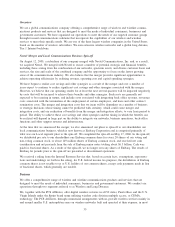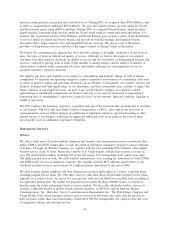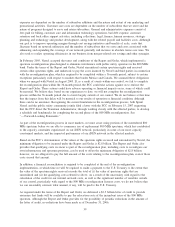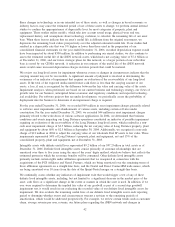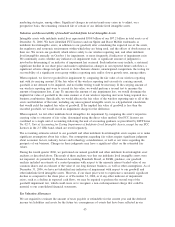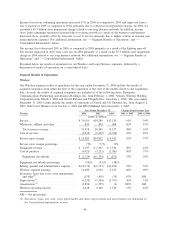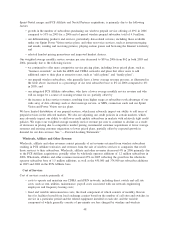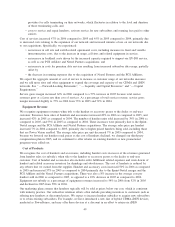Sprint - Nextel 2006 Annual Report Download - page 46
Download and view the complete annual report
Please find page 46 of the 2006 Sprint - Nextel annual report below. You can navigate through the pages in the report by either clicking on the pages listed below, or by using the keyword search tool below to find specific information within the annual report.consolidated financial statements or tax returns for each taxing jurisdiction in which we operate. This process
requires our management to make assessments regarding the timing and probability of the ultimate tax impact.
We record valuation allowances on deferred tax assets if we determine it is more likely than not that the asset
will not be realized. Additionally, we establish reserves for uncertain tax positions based upon our judgment
regarding potential future challenges to those positions. Actual income taxes could vary from these estimates
due to future changes in income tax law, significant changes in the jurisdictions in which we operate, our
inability to generate sufficient future taxable income or unpredicted results from the final determination of
each year’s liability by taxing authorities. These changes could have a significant impact on our financial
position.
The accounting estimate related to the tax valuation allowance requires us to make assumptions regarding the
timing of future events, including the probability of expected future taxable income and available tax planning
opportunities. These assumptions require significant judgment because actual performance has fluctuated in
the past and may do so in the future. The impact that changes in actual performance versus these estimates
could have on the realization of tax benefits as reported in our results of operations could be material.
We carried an income tax valuation allowance of $953 million as of December 31, 2006. This amount includes
a valuation allowance of $743 million for the total tax benefits related to net operating loss carryforwards,
subject to utilization restrictions, acquired in connection with certain acquisitions. The remainder of the
valuation allowance relates to capital loss, state net operating loss and tax credit carryforwards. Within our
total valuation allowance we had $54 million related to separate company state net operating losses incurred
by the PCS entities while owned by us. The valuation allowance was provided on these separate company
state net operating loss benefits since these entities had no history of taxable income. Current trends indicate
that the valuation allowance continues to be appropriate and we do not anticipate adjusting this amount in the
near term. We continue to monitor these trends, and in the future it is possible that our cumulative historical
test will ultimately yield sufficient positive evidence that it is more likely than not that we will realize the tax
benefit of some of the separate company state net operating losses for which the valuation allowance has been
provided. Should that occur, subject to review of other qualitative factors and uncertainties at that time, we
would expect to start reversing some of the valuation allowance. For the valuation allowance related to the
acquired tax benefits described above, we would first reduce goodwill or intangible assets resulting from the
acquisitions, or reduce income tax expense if these intangible assets have been reduced to zero. For the
remainder of our valuation allowance, we would reduce income tax expense. Assumption changes that result
in a change of expected benefits from realization of capital loss, state net operating loss and tax credit
carryforwards by 10% would result in a decrease or increase in our valuation allowance by $38 million, which
would be reflected in the statement of operations.
Significant New Accounting Pronouncements
In September 2006, the FASB issued SFAS No. 157, Fair Value Measurements. This statement defines fair
value and establishes a framework for measuring fair value. Additionally, this statement expands disclosure
requirements for fair value with a particular focus on measurement inputs. SFAS No. 157 is effective for our
quarterly reporting period ending March 31, 2008. We are in the process of evaluating the impact of this
statement on our consolidated financial statements.
In September 2006, the EITF reached a consensus on Issue No. 06-1, Accounting for Consideration Given by
a Service Provider to Manufacturers or Resellers of Equipment Necessary for an End-Customer to Receive
Service from the Service Provider. EITF Issue No. 06-1 provides guidance regarding whether the consideration
given by a service provider to a manufacturer or reseller of specialized equipment should be characterized as a
reduction of revenue or an expense. This issue is effective for our quarterly reporting period ending March 31,
2008. Entities are required to recognize the effects of applying this issue as a change in accounting principle
through retrospective application to all prior periods unless it is impracticable to do so. We are in the process
of evaluating the impact of this issue on our consolidated financial statements.
In June 2006, the EITF reached a consensus on Issue No. 06-3, How Taxes Collected from Customers and
Remitted to Governmental Authorities Should Be Presented in the Income Statement (That Is, Gross Versus Net
44



